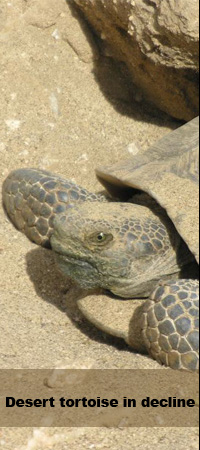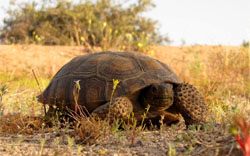 | The desert tortoise has lived in the Mojave and Colorado/Sonoran deserts of California, southern Nevada, Arizona, southwestern Utah, and in Mexico for thousands of years. This reptile is able to survive ground temperature exceeding 140 degrees F and is known to live as long as 60 to 80 years. |
Much of the tortoise’s water intake comes from moisture in the grasses and wildflowers. The water is stored in the bladder of the tortoise allowing it to live off of this reservoir for many months. | 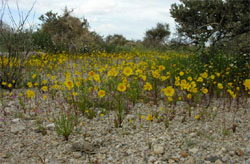 |
 | Ninety-five percent of the life of a desert tortoise is spent in the ground escaping the heat in a burrow or den. During hibernation their heart rate, respiration rate, and all bodily processes are slowed down. Burrows can be easily crushed by off-highway vehicles that do not stay on established roads. |
This desert tortoise is feeding on a dune primrose during spring. Non-native Sahara mustard seen in the background is a weed that competes with the native plants for water and nutrients. In some areas, mustard grows so densely that it is nearly impossible for desert tortoises to pass through. Vehicles, which do not stay on established roads and do not get washed frequently, contribute to spreading weeds. | 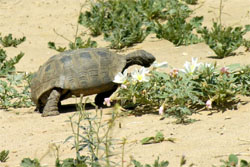 |
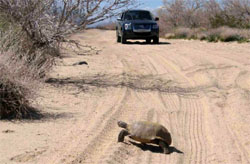 | Poaching and driving off-highway vehicles within tortoise habitat continues to threaten tortoise populations. During the hottest part of the day, desert tortoises seek shade; and they sometimes find it under parked cars. For this reason, it is important to check under the car for desert tortoises before taking off. |
This is the carcass of a desert tortoise, which was run over by an off-highway vehicle. Local people observed how people from outside of their community came to visit the area for the weekend to race their off-road vehicles and dirt bikes through the desert. Although rules for off-highway vehicle users exist, they are frequently not followed. | 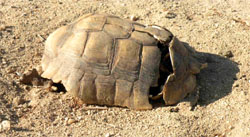 |
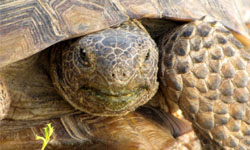 | Desert tortoises are also threatened by several diseases such as the upper respiratory tract disease often found in captive tortoises. Pet owners releasing sick tortoises into the wild has resulted in diseases being spread to wild tortoises. |
Trash, such as this deflated balloon, poses a threat to desert tortoises. The balloon can be mistaken for food by desert tortoises and, once consumed, may remain in the stomachs and intestines giving them a false sense of fullness that may cause them to starve. | 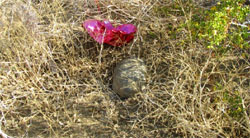 |
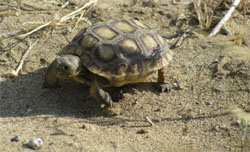 | Unlike adult desert tortoises, juveniles have fragile thin shells. Ravens eat tortoises by pecking at their shells and eating what is inside. Fifty years ago raves used to be uncommon in the desert, but their population has increased 700 percent. Under natural circumstances, the raves would not do well in the harsh desert environment, but opportunistic bird species is thriving because humans make food and water sources available, including landfills, illegal dumps, unsecured dumpsters and trash cans, man-made ponds, irrigation systems, and road kill. |
Ways to protect desert tortoises from raven predation:
Store your trash in containers with tightly secured lids. Don’t litter.
Encourage landfill managers to reduce raven attractants.
If you live in the desert, landscape your garden with native plants that don’t require watering.
If watering of your garden is still necessary, ensure that it does not run over the curb or fills in depressions. Ravens can detect the smallest puddles.
Ask local and county governments to teach residents and businesses how to prevent ravens from accessing trash and to take other measures to reduce food and water sources available to ravens. Your voice matters!
| 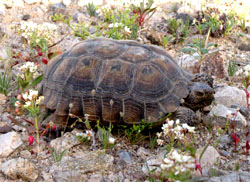 |

